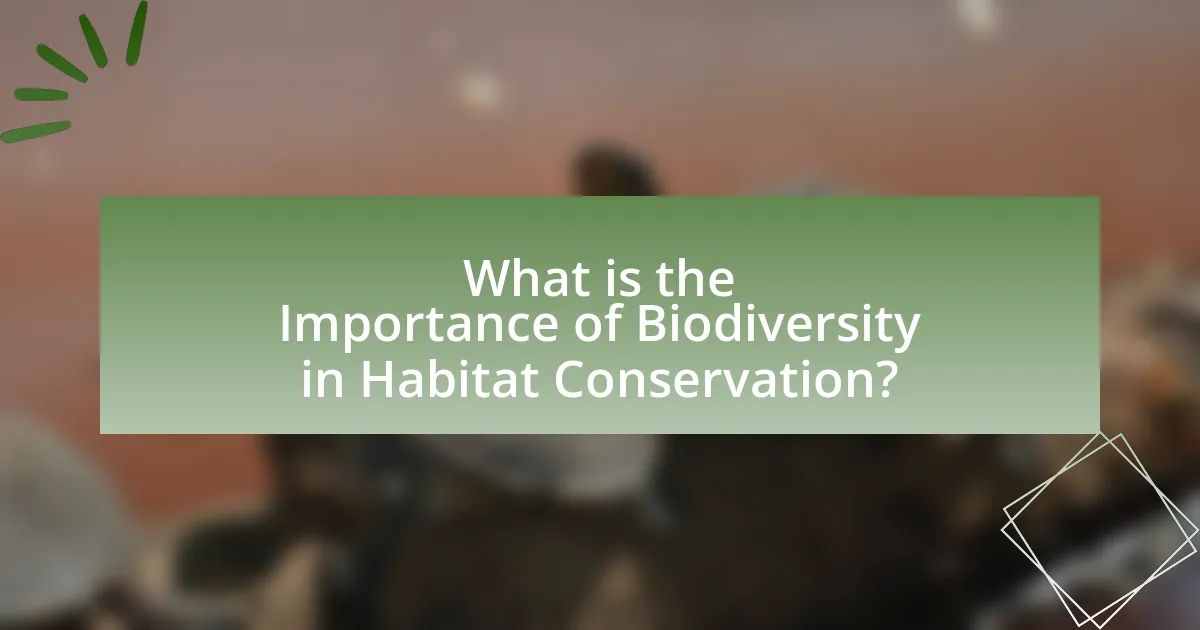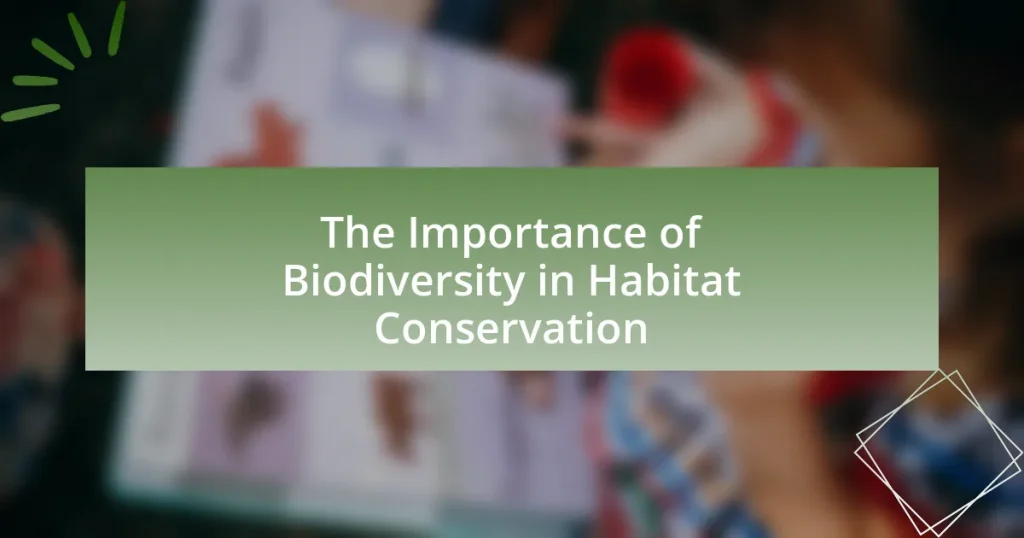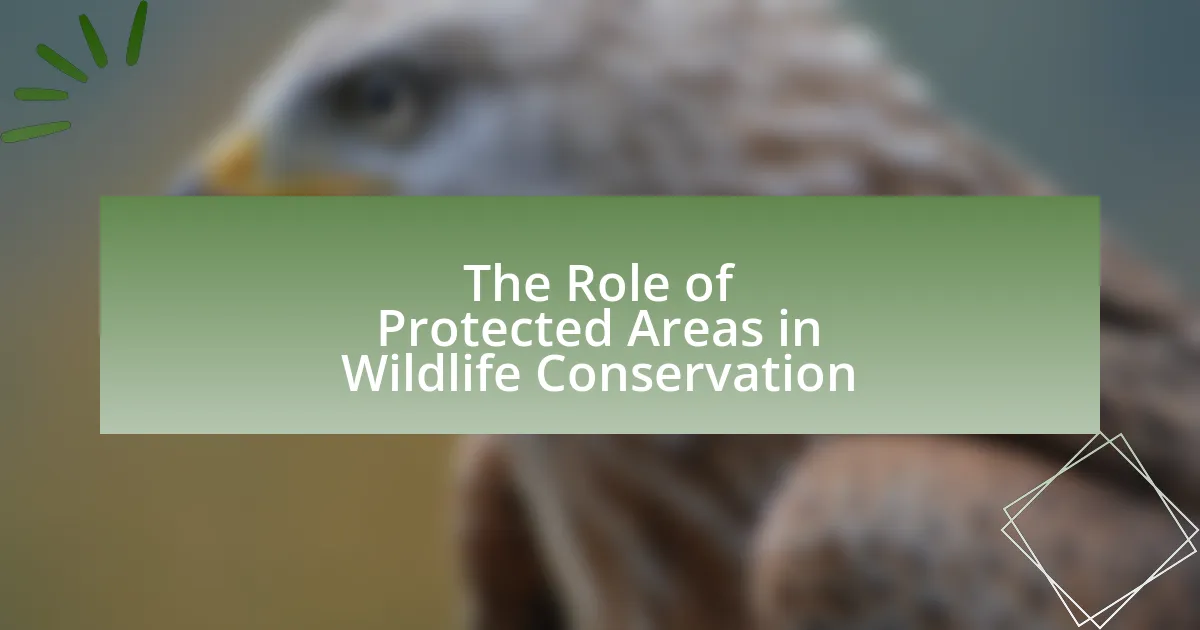Biodiversity is essential for habitat conservation, as it enhances ecosystem resilience, stability, and productivity. Diverse ecosystems are better equipped to withstand environmental changes and disturbances, which is crucial for maintaining vital ecosystem services such as clean water and pollination. The article explores the roles different species play in maintaining ecosystem balance, the impact of biodiversity loss on habitat stability, and the key threats to biodiversity, including climate change and habitat destruction. It also discusses effective strategies for promoting biodiversity in conservation efforts, the importance of community involvement, and the role of policy and legislation in supporting biodiversity initiatives.

What is the Importance of Biodiversity in Habitat Conservation?
Biodiversity is crucial for habitat conservation as it enhances ecosystem resilience, stability, and productivity. Diverse ecosystems can better withstand environmental changes and disturbances, such as climate change and natural disasters. For instance, a study published in the journal “Nature” found that ecosystems with higher species diversity are more productive and can recover more quickly from disturbances. This resilience is vital for maintaining ecosystem services, such as clean water, pollination, and carbon storage, which are essential for human survival and well-being. Therefore, preserving biodiversity directly supports the health and sustainability of habitats.
Why is biodiversity crucial for ecosystem health?
Biodiversity is crucial for ecosystem health because it enhances resilience, stability, and productivity of ecosystems. Diverse species contribute to various ecological functions, such as nutrient cycling, pollination, and pest control, which are essential for maintaining ecosystem balance. For instance, ecosystems with a higher number of species are better able to withstand environmental stressors, such as climate change and disease outbreaks, as evidenced by studies showing that diverse plant communities can recover more quickly from disturbances compared to monocultures. This interdependence among species ensures that ecosystems can adapt and thrive, ultimately supporting human well-being and the services ecosystems provide.
What roles do different species play in maintaining ecosystem balance?
Different species play crucial roles in maintaining ecosystem balance through various interactions that support biodiversity and ecological stability. For instance, producers like plants convert sunlight into energy, forming the base of food webs, while consumers, such as herbivores and carnivores, regulate population sizes and contribute to nutrient cycling. Decomposers, including fungi and bacteria, break down organic matter, returning essential nutrients to the soil, which supports plant growth. This interconnectedness ensures that ecosystems function effectively, as evidenced by studies showing that ecosystems with higher biodiversity are more resilient to disturbances, such as climate change and invasive species. For example, a study published in “Nature” by Cardinale et al. (2012) found that diverse ecosystems are more productive and better at withstanding environmental stressors, highlighting the importance of species diversity in ecosystem health.
How does biodiversity contribute to resilience against environmental changes?
Biodiversity enhances resilience against environmental changes by providing a variety of species that can adapt to shifting conditions. This diversity ensures ecosystem stability, as different species fulfill various ecological roles, allowing ecosystems to maintain functionality even when some species are affected by changes such as climate shifts or habitat loss. For instance, ecosystems with high biodiversity can recover more quickly from disturbances, as seen in studies where diverse coral reefs showed greater resilience to bleaching events compared to less diverse reefs. This adaptability is crucial for sustaining ecosystem services, such as pollination and water purification, which are vital for human survival and environmental health.
How does biodiversity impact habitat conservation efforts?
Biodiversity significantly enhances habitat conservation efforts by maintaining ecosystem resilience and functionality. Diverse ecosystems are better equipped to withstand environmental changes and disturbances, which is crucial for effective conservation. For instance, a study published in the journal “Nature” found that ecosystems with higher species diversity can recover more quickly from stressors such as climate change and habitat destruction. This resilience is vital for sustaining the services that ecosystems provide, such as clean water, pollination, and carbon storage, which are essential for both human well-being and the health of the planet. Therefore, promoting biodiversity is integral to successful habitat conservation strategies.
What are the direct benefits of preserving diverse species in habitats?
Preserving diverse species in habitats directly benefits ecosystems by enhancing resilience, promoting stability, and supporting ecosystem services. Biodiversity contributes to the functioning of ecosystems, allowing them to recover from disturbances and adapt to changes, such as climate fluctuations. For instance, diverse plant species can improve soil health and nutrient cycling, which are essential for agricultural productivity. Additionally, a study published in the journal “Nature” found that ecosystems with higher species diversity are more productive and provide greater services, such as pollination and water purification, which are vital for human survival and economic activities.
How does loss of biodiversity affect habitat stability?
Loss of biodiversity negatively impacts habitat stability by reducing ecosystem resilience and functionality. When species diversity declines, ecosystems become more vulnerable to disturbances such as climate change, invasive species, and disease outbreaks. For instance, a study published in the journal “Nature” found that ecosystems with higher biodiversity are better able to withstand environmental stressors, as diverse species contribute to various ecological processes, such as nutrient cycling and pollination. Consequently, the loss of species disrupts these processes, leading to decreased habitat stability and increased susceptibility to collapse.
What are the key threats to biodiversity in habitats?
Key threats to biodiversity in habitats include habitat destruction, climate change, invasive species, pollution, and overexploitation. Habitat destruction, primarily due to urbanization and agriculture, leads to loss of ecosystems and species. Climate change alters temperature and precipitation patterns, affecting species’ survival and distribution. Invasive species disrupt local ecosystems by outcompeting native species for resources. Pollution, including chemical runoff and plastic waste, degrades habitats and harms wildlife. Overexploitation of resources, such as overfishing and deforestation, further diminishes biodiversity. These factors collectively threaten the stability and resilience of ecosystems, as evidenced by the ongoing decline in species populations globally.
How do human activities contribute to biodiversity loss?
Human activities contribute to biodiversity loss primarily through habitat destruction, pollution, overexploitation, and climate change. Habitat destruction, such as deforestation and urbanization, leads to the fragmentation and loss of ecosystems, which directly reduces the number of species that can thrive in those areas. According to the World Wildlife Fund, approximately 1 million species are at risk of extinction due to habitat loss and degradation. Pollution from agricultural runoff, plastics, and industrial waste further degrades ecosystems, harming species and disrupting food chains. Overexploitation of resources, including overfishing and poaching, depletes populations of various species, pushing them closer to extinction. Additionally, climate change alters habitats and species distributions, making it difficult for many organisms to survive. The Intergovernmental Science-Policy Platform on Biodiversity and Ecosystem Services reports that climate change is a significant driver of biodiversity loss, affecting ecosystems globally.
What role does climate change play in threatening biodiversity?
Climate change significantly threatens biodiversity by altering habitats, disrupting ecosystems, and increasing extinction rates. Rising temperatures and changing precipitation patterns lead to habitat loss, as species struggle to adapt to new conditions or migrate to suitable environments. For instance, a study published in “Nature” by Thomas et al. (2004) estimated that climate change could drive 15-37% of species to extinction if global temperatures rise by 2°C. Additionally, ocean acidification and warming threaten marine biodiversity, impacting coral reefs and fish populations. These changes disrupt food webs and ecological balance, further endangering species survival.
How can we promote biodiversity in habitat conservation?
Promoting biodiversity in habitat conservation can be achieved through the establishment of protected areas and the implementation of sustainable land-use practices. Protected areas, such as national parks and wildlife reserves, serve as critical refuges for diverse species, helping to maintain ecological balance. According to the International Union for Conservation of Nature, over 15% of the world’s terrestrial areas are designated as protected, which has been shown to significantly enhance species richness and ecosystem resilience. Additionally, sustainable land-use practices, such as agroforestry and organic farming, reduce habitat destruction and promote species diversity by integrating conservation efforts into agricultural systems. Research published in the journal “Nature” indicates that agroecological practices can increase biodiversity by up to 50% compared to conventional farming methods.
What strategies are effective in enhancing biodiversity in conservation areas?
Effective strategies for enhancing biodiversity in conservation areas include habitat restoration, the establishment of protected areas, and the implementation of sustainable land-use practices. Habitat restoration involves rehabilitating degraded ecosystems to support native species, which has been shown to increase species richness and abundance. The establishment of protected areas, such as national parks and wildlife reserves, safeguards critical habitats from development and exploitation, leading to improved biodiversity outcomes. Additionally, sustainable land-use practices, such as agroforestry and organic farming, promote biodiversity by maintaining ecological balance and reducing habitat fragmentation. Research indicates that these strategies collectively contribute to the resilience of ecosystems and the preservation of biodiversity, as evidenced by studies demonstrating increased species diversity in restored habitats compared to degraded ones.
How can community involvement support biodiversity initiatives?
Community involvement can significantly support biodiversity initiatives by fostering local stewardship and enhancing conservation efforts. Engaged communities often participate in habitat restoration projects, which directly contribute to the preservation of local ecosystems. For example, studies show that community-led initiatives, such as tree planting and invasive species removal, can lead to a 30% increase in native species diversity in affected areas. Furthermore, local knowledge and cultural practices can inform sustainable management strategies, ensuring that biodiversity initiatives are tailored to specific ecological contexts. This collaborative approach not only strengthens community ties but also promotes long-term commitment to biodiversity conservation.
What are the best practices for integrating biodiversity into habitat conservation plans?
The best practices for integrating biodiversity into habitat conservation plans include conducting comprehensive biodiversity assessments, engaging stakeholders, and implementing adaptive management strategies. Comprehensive biodiversity assessments identify species and ecosystems present in the area, allowing for targeted conservation efforts. Engaging stakeholders, including local communities and conservation organizations, ensures that diverse perspectives are considered, fostering collaboration and support for conservation initiatives. Implementing adaptive management strategies allows for ongoing evaluation and adjustment of conservation actions based on ecological feedback, enhancing the effectiveness of the plans. These practices are supported by research indicating that inclusive and informed approaches lead to more successful conservation outcomes, as seen in case studies like the European Union’s Biodiversity Strategy, which emphasizes stakeholder involvement and adaptive management.
How can monitoring and assessment improve biodiversity outcomes?
Monitoring and assessment can significantly improve biodiversity outcomes by providing data that informs conservation strategies and management practices. By systematically tracking species populations, habitat conditions, and ecological interactions, stakeholders can identify trends, threats, and opportunities for intervention. For instance, a study published in the journal “Biodiversity and Conservation” found that regular monitoring of bird populations led to targeted conservation efforts that increased species richness in specific areas by 30% over five years. This evidence demonstrates that effective monitoring and assessment enable adaptive management, ensuring that conservation actions are responsive to changing environmental conditions and biodiversity needs.
What role do policy and legislation play in supporting biodiversity conservation?
Policy and legislation are crucial in supporting biodiversity conservation by establishing legal frameworks that protect ecosystems and species. These regulations, such as the Endangered Species Act in the United States, provide mechanisms for habitat protection, species recovery plans, and penalties for violations, thereby incentivizing conservation efforts. Additionally, international agreements like the Convention on Biological Diversity set global targets for biodiversity preservation, guiding national policies and fostering cooperation among countries. Such legal instruments ensure that biodiversity conservation is prioritized in land-use planning and resource management, ultimately contributing to the sustainability of ecosystems and the services they provide.
What practical steps can individuals take to support biodiversity in their local habitats?
Individuals can support biodiversity in their local habitats by creating native plant gardens, which provide essential food and shelter for local wildlife. By planting native species, individuals can enhance local ecosystems, as these plants are adapted to the local climate and soil, requiring less water and maintenance compared to non-native species. Research indicates that native plants support a higher diversity of pollinators and other beneficial insects, which are crucial for ecosystem health. Additionally, individuals can reduce pesticide use, as chemicals can harm non-target species and disrupt food webs. Engaging in local conservation efforts, such as participating in clean-up events or habitat restoration projects, further contributes to preserving biodiversity. These actions collectively foster healthier ecosystems and promote the resilience of local wildlife populations.




